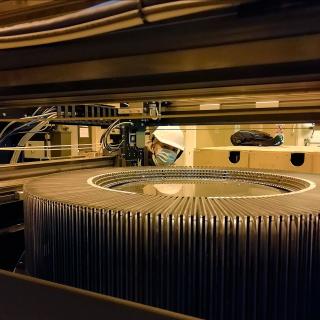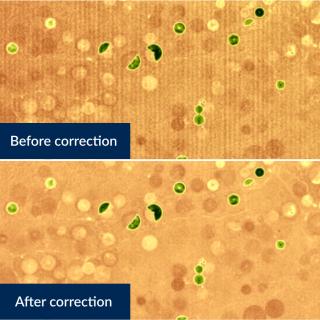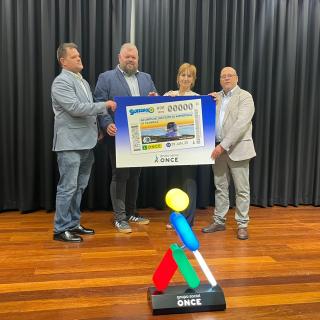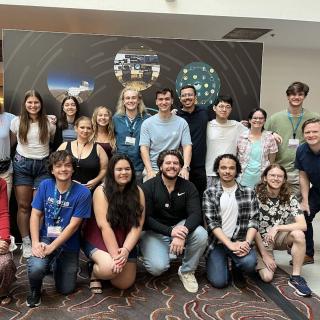Yesterday, 30 October 2023, from the telescope itself at the Roque de los Muchachos Observatory on the island of La Palma, the WEAVE instrument, a powerful state-of-the-art multi-fibre spectrograph, was publicly unveiled.
The inauguration ceremony brought to La Palma the leaders of the science funding agencies from the partner countries of the Isaac Newton Group of Telescopes (ING), as well as a strong representation from the 500 members of the science teams and the organisations involved in the design and construction of WEAVE, making it the largest ever gathering of people inside the dome of the WHT.
The inauguration ceremony was full of excitement and celebration. The WEAVE project was launched more than 10 years ago thanks to the push of a great team of astronomers who saw in wide-field spectroscopy using optical fibres the potential to exploit large data sets, such as those provided by the European Space Agency's (ESA) Gaia satellite, and a new role for the William Herschel Telescope, now refurbished and equipped with one of the largest astronomical lenses ever built.
Rafael Rebolo, director of the Instituto de Astrofísica de Canarias (IAC), said in his speech that "WEAVE is a cutting-edge instrument with which the WHT telescope will have at least 10 years of excellent scientific production ahead of it. It is the result of a long and successful collaboration between the Science Councils of the UK, the Netherlands and the IAC to make the WHT telescope a world leader in wide-field spectroscopic surveys. "I am confident that this collaboration will continue for a long time, will continue to deliver excellent results and will enhance the capabilities of our scientific communities and those of all the groups that have contributed to making this magnificent instrument a reality," he concluded.
After intense years of design and construction of its multiple elements in countries on four continents, WEAVE was finally installed at the WHT in May 2022, and it obtained its first scientific data in December of the same year. During 2023, several of its observation modes have been fine-tuned, and data have been obtained to verify its scientific capabilities.
The inauguration of WEAVE marks the beginning of its regular scientific exploitation, and more specifically, the kick-off of the WEAVE Survey and open-time programmes using its large integral-field unit (LIFU). Science programmes using the multi-object spectroscopy (MOS) mode are due to start in 2024, followed by observations with WEAVE's third observing mode using small integral-field units (mIFU).
WEAVE, the instrument
WEAVE is a multi-mode, multi-fibre spectrograph which uses optical fibres to gather light from celestial sources and transmit it to a spectrograph. The WEAVE two-arm spectrograph separates the light into its different wavelengths, or colours, and records them on large-format CCD detectors. The raw data are transferred over the internet to computers in Cambridge and Tenerife, and the science-ready products are stored in an archive on La Palma for scientific exploitation. The resulting spectra contain the fingerprints of the physical and chemical properties of stars, galaxies, quasars and interstellar and intergalactic gas, which astronomers use to test their theories about the Universe, and which also enable astronomers to measure velocities along the line of sight through the Doppler effect.
One of WEAVE's unique features among multi-object spectrographs is its superb sharpness when splitting the incoming light into its component wavelengths, also known as spectral resolving power, for as many as 960 celestial sources simultaneously. While the spectral resolving power of WEAVE in low-resolution mode is comparable to that of other current multi-object spectrographs, its resolving power in high-resolution mode is five to ten times greater than that of other multi-object facilities in the northern hemisphere. This high resolving power means more accurate velocity measurements (as good as 1 km/s) and much more accurate chemical-abundance measurements than can be obtained with other northern-hemisphere MOS facilities.
WEAVE's versatility is another of its strengths. While the LIFU mode hosts 547 fibres closely-packed to image extended areas of the sky, in the MOS mode two robots separately position up to 960 individual fibres to gather light from as many stars, galaxies or quasars. In the mIFU mode, the fibres are organised into 20 units, each comprising 37 fibres that are used to study small extended targets such as nebulae and distant galaxies.
*More information on the WEAVE instrument can be found on the official ING website here: https://www.ing.iac.es/PR/press/weave_inauguration.html







